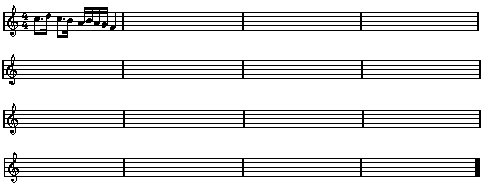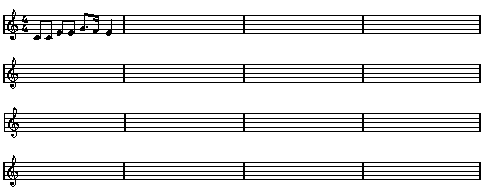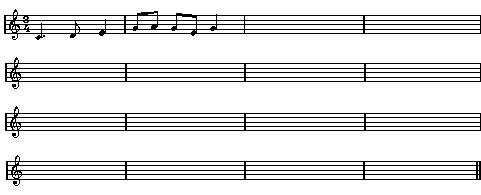Composing practice using sequence
1. Simple sequences (Exercises A, B & C)
Continue the given one-bar figures to create a four-bar phrase which makes use of sequence. This can be an ascending or descending sequence, as you like. You may like to create an ending in the fourth bar which is not directly related to the original opening figure. Note that if you finish on the notes C or E (notes of the I chord) the music will sound quite complete. If you finish on the notes G, B, D or F (notes of the V7 chord) the music will feel as if it wants to go on.
2. Re-shaping sequences (Exercises D, E & F)
Now you will invert the sequences you have already composed in the simple sequence exercises (1 – A, B & C). Musically, to invert something means that you make the intervals between the notes in a musical idea or musical phrase go in the opposite direction, i.e. up, not down, or down, not up! But when you do this the intervals (distance) between the notes should always be the same as the original.
To show this, compare the the given beginnings to exercises D, E & F to those of exercises A, B & C. D, E & F are inversions of A, B & C.
Continue these inverted openings to form complete inversions of the sequential phrases you have created in exercises A, B & C. Again, you might like to adapt the ending more freely.
3. Balancing phrases which use sequence (Exercises G, H and I)
As exercises A and D above (or B and E; or C and F) used similar musical ideas, they should make a fitting pair together. Just just having the one four-bar tune (or phrase) follow the other is not always enough to make them sound completely convincing musically . Now you have to decide:
- in which order the two ideas should best be presented
- whether the endings of the two phrases are appropriate, i.e., should you alter what you wrote earlier a little to make the end of the first phrase link nicely into the second (perhaps by finishing on a note of the V chord) and perhaps make the second phrase come to a more conclusive end (perhaps by finishing on the tonic note C).
Write your resulting 8-bar melodies neatly on music paper:
- Ex 3. G (made up of A & D adapted)
- Ex. 3. H (made up of B & E adapted)
- Ex. 3. I (made up of C & F adapted)
4. More complex sequences (Exercises J, K & L)
If a musical figure has several strong musical elements in it, like the opening of ex. B above (rising and descending sixteenths/semiquavers; then descending eighths/quavers), you can extend the original not only by making sequences of the whole figure, but also by making sequences of smaller elements within the original idea. See how this example treats the sixteenth notes/semiquavers and the eighths/quavers – and their inversions (see ex. E) – as separate units for musical development.
Listen to it to support your analysis: 4. Above example
Continue these openings to create a melody of 8, 12 or 16 bars. They should use sequence of the opening figure or elements from the opening figure. Invert the given material too.








